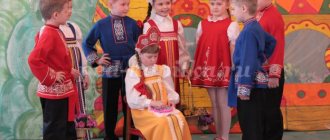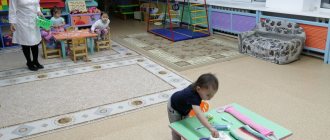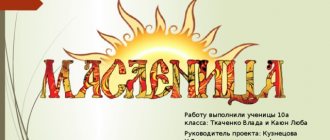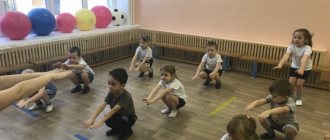The library as a means of developing a preschool reader
Zhusova Elena Viktorovna, senior teacher,
MBDOU d/s No. 83, Taganrog
The library as a means of developing a preschool reader
Currently, educational institutions are faced with the task of introducing children to books and cultivating an interest in reading. It is very important to introduce children to book culture and raise inquisitive, literate people. Fiction plays an important role in a child’s social and communicative competence. The book serves as a powerful, effective means of mental, moral and aesthetic education of children; it has a huge impact on the development and enrichment of the child’s speech, the development of his social skills. The images of fiction open and explain to the child the life of society and nature, the world of human feelings and relationships. The plots of literary works become the plots of children's games. By living the lives of the heroes in the game, children gain their spiritual and moral experience.
Thus, through the correct selection of books, one can have a beneficial effect on the moral development of a child’s personality and on the formation of his spiritual values.
Thus, one of the main tasks of modern society is to develop the need for reading in children. In our kindergarten, each group has book corners, which are mini-libraries; the books presented in them are designed for ages from 4 to 7 years. Of course, most of the book corners are made up of fiction books (fairy tales, poems, stories). But the older children become, the more interesting they become in books from the educational and research section (scientific literature), as well as works by foreign authors.
The specifics of childhood culture dictate the need to build a special library space that takes into account the age and psychological characteristics of children and meets the spiritual and cognitive needs of the child. At first, children's interest in a book depends entirely on adults, on their ability to choose a book, read it out loud, and talk about it. The children's library becomes an assistant in this matter. Revealing to pupils the variety of books, realizing the task of developing the child as a reader, our kindergarten has been working closely with the library named after. N. Ostrovsky, Taganrog, together with employees, with whom we have the opportunity to provide children with the best conditions for cultural development, meeting their diverse needs through the information resources available in the library.
Children's library staff are well aware of the tasks of developing children's reading competence. The choice of means and methods of attracting reading corresponds to the capabilities of children. Together with the library, kindergarten teachers try to instill in children a love of books and reading, and organize various forms of public events: literary and themed evenings (“Chekhov readings,” “The feat of the people is dear to us,” dedicated to the victory in the Second World War, “Who are they birds? ", etc.), various games, competitions, exhibitions, promotions; conduct reviews of new literature. The children are looking forward to their next visit to the library.
Visits to the library have become a tradition for teachers and students of our kindergarten. But it is always interesting to watch children who come to the library for the first time discover this diverse world of literature. Thus, as part of the celebration of International Children's Book Day and in order to expand the knowledge of preschoolers about books, the pupils visited the library named after. N. Ostrovsky, Taganrog. Library workers warmly welcomed the children and offered to take an exciting journey into the world of books.
The preschoolers listened with great interest to the librarian’s story. She introduced the children to the book collection; spoke about the emergence of printing; about what kinds of books there are, and which of them are included in the Guinness Book of Records; about proper handling of books; that books come in different sizes, big and small. The children learned that the smallest book is the size of a needle point, and the largest is 6 meters long and weighs 500 kilograms. The librarian introduced the children to unusual books. Preschoolers learned that the library has “nosy” and “touching” books, looked at them with enthusiasm, and some were even able to read the stories that were told in these books.
Library staff held a fascinating quiz with the children, “A Journey through Fairy Tales,” during which the children happily answered questions and showed their knowledge of many fairy tales, both original and folk. The children looked with great delight at the many books in beautiful bindings, neatly arranged on wonderfully decorated shelves. Children have never seen so many books before. The excursion made a huge impression on the students. The children did not want to leave the library, and they promised to return with their parents.
Thus, the joint activities of kindergarten teachers with the library staff named after. N. Ostrovsky in Taganrog gives preschoolers the opportunity to see the library as a place where it is interesting to be, where you can learn a lot of new things, where a space is organized, surrounded by books, allowing you to provide materials that can help in the further development of the child. After all, the main goal of children's libraries is the formation and satisfaction of children's needs for intellectual and spiritual growth, self-knowledge and self-education; introducing children to reading, world and national culture; promoting the value of reading and books; promoting the integration of children into the sociocultural environment of society. In other words, to create an environment for the child’s development through reading books and other types of materials that meet his gender, age, sociocultural and individual characteristics.
Consultation for educators Topic: “Mini-library in a group” consultation on the topic
Consultation for educators
Topic: “Mini-library in a group”
In order to develop children's interest in fiction and cultivate a caring attitude towards books, a developmental one is created in each group. This is a calm, comfortable, aesthetically designed place where children have the opportunity to communicate with a book, look at illustrations, magazines, and albums.
There are a number of requirements for the design of the “Mini-Library”:
- convenient location - a quiet place, away from the doors to avoid walking and noise; good illumination during the day and evening, proximity to the light source (not far from the window, presence of a lamp in the evening), so that children do not damage their eyesight;
- aesthetic design - the book corner should be cozy, attractive, with slightly different furniture. Decoration can be a bust or portrait of a writer, or objects of folk and applied art.
In the corner there should be shelves or display cases on which books and reproductions of paintings by famous artists are displayed. It’s good to have a closet nearby to store books, albums, and materials for repairs. You can store characters and scenery for a shadow theater in it. There are different options for designing a corner.
A periodic change of material (literature, paintings, portraits) and connection with educational work in the group is necessary. For example, in a book corner you can prepare children for a conversation about Moscow: look at illustrations, photographs, make an album.
In younger groups, children are just developing the skill of using a book. Often, they use it as a toy. The “Mini Library” should contain 3–4 books suitable for children, but there must be several copies of the same title, individual pictures, and a thematic album. Books should have a small amount of text, with large colorful illustrations - picture books: fairy tales “Kolobok”, “Turnip”; “Toys” by A. Barto, “Fire Horse” by V. Mayakovsky, “Mustachioed and Striped” by S. Marshak, etc. A lot of material is not given, this leads to disorganization of children’s behavior. The teacher accustoms children to independently communicate with the book, looks at the illustrations with them, reads the text, talks about the rules of use (do not draw in the book, do not tear it, take it with clean hands, etc.).
In the middle group, a “Mini Library” is organized from the very beginning of the year with the participation of children. There are 4-5 books on the display shelf, the rest are stored in the closet. In addition to books and albums, shadow theater props and repair materials (paper, fabric, scissors, glue, etc.) are gradually introduced. The requirements for books remain the same. Picture books are used less frequently. They keep the children's favorite books from the younger group, add new fairy tales, poetic works, books about nature, and funny books. In the corner of the book you can display children's drawings on the themes of works of art.
The teacher continues to teach children to look at books and illustrations, drawing their attention to the plot and sequence of events. Conversations are held about books, it is found out whether children know their contents, whether they understand the meaning of the illustrations; There is talk about literary works that are read to children at home. Children develop stable skills in handling books carefully. For this purpose, children are involved in selecting books that need repair and putting things in order. They continue to introduce children to the basic rules (look at books only at the table, do not fold the pages, do not bend the cover, etc.). You should give instructions more often: check the order in the book corner before leaving the group, find a book that the teacher wants to read, etc. Book repairs in the junior and middle groups are carried out by the teacher himself, but in the presence of children and with their help. Five-year-old children can be involved in simple gluing of bindings, in making an album with pictures, and in making character crafts for a shadow theater.
In senior and preparatory school groups, the content of the “Mini-Library” becomes more versatile due to genre and thematic diversity. The number of books on display is increased to 8–10, but children should have more books at their disposal. Children can use the library independently. Taking into account the changes that have occurred in the literary development of children, the list of fiction is being expanded to include different authors, different topics and different genres, as well as children’s magazines. The list includes Russian folk tales and tales of the peoples of the world, literary tales of Russian and foreign authors, works of Russian classics and modern writers. Thematically, there should be works about nature, scientific-educational, humorous, etc., of different formats, with and without illustrations.
Books for display are selected taking into account the interests of children, their knowledge about the work of a particular writer, anniversaries, seasons, and educational goals. There are no specific deadlines for changing the material; it depends primarily on the interest of the children and is determined by the teacher.
In addition to reading and storytelling by the teacher, in relation to older children, such forms of work as conversations about books, organizing book exhibitions, conversations about writers and artists, and literary matinees are used.
The content of a conversation about a book can be a conversation about its appearance (cover with the title, name of the author and artist; sheets and pages, their numbering; beginning and end); books are written by writers and poets; they are printed in a printing house; fairy tales, riddles, stories, and poems are printed in them.
A problematic question is appropriate: “Why do they say that a book is a man’s friend?” You need to tell the children that books are designed by different artists, consider several books. At the end of the conversation, you can ask what rules for using the book the children know. The conversation ends emotionally: by reading a funny story or poetry. A continuation of this conversation could be a story about how books are made.
A conversation about writers can be interesting. In the process, it becomes clear what people who write stories and poems are called; what writers and poets children know and what books they wrote, what they tell about. You can review their favorite books with your children. At the end of the conversation, you can agree on organizing an exhibition of books by one writer or several favorite writers. Children's book exhibitions are associated with the writer's anniversary, with Book Week, and with a literary matinee.
Before children enter school, it is useful to organize an exhibition “Our Favorite Books and Paintings.” Children and individual parents take part in its preparation. The selection of books must be strict (art design, different editions of the same book, appearance, etc.). The exhibition can last no more than three days, as children’s interest in it quickly wanes.
Work is carried out with older preschoolers to get acquainted with artists - illustrators of children's books. As a result, children develop artistic taste, broaden their horizons, deepen their perception of a literary work, and develop creative abilities. The teacher, telling a fairy tale or reading a story, connects the text with the illustration and names the artist. During conversations, he introduces children to some interesting and accessible facts of his biography, creativity, and style of performance. Illustrations by different artists for one work are compared. Quizzes and exhibitions are held.
In their work on getting acquainted with the works of children's book artists (Yu. S. Vasnetsov, Yu. D. Korovin, V. V. Lebedev, A. F. Pakhomov and others), teachers will be helped by the work experience of educators, which is described in the book by G. N. Doronova “For preschoolers about children’s book artists” (M., 1991).
The literary development of children is facilitated by matinees, leisure evenings dedicated to the work of a writer or poet, evenings of fairy tales, riddles, literary quizzes (on folk tales, on the works of one author, on well-known books by different writers). The combination of different types of arts - music, fiction, visual arts - creates a festive atmosphere. All forms of work to introduce children to fiction outside of class foster interest and love for books and shape future readers.





